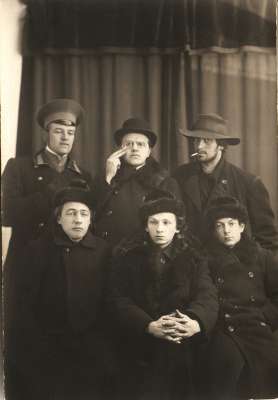Г. Л. Кузьмин и С. Д. Долинский знамениты, в частности, тем, что в 1912 году издали футуристский манифест "Пощечина общественному вкусу". О них можно найти дополнительную информацию в статье об Л. Л. Кузьмине. Издатель Цезарь Александрович Мюнстер был сыном знаменитого русского литографа Александра Эрнестовича Мюнстера, открывшего свое литографическое заведение в Санкт-Петербурге в 1850 году. Судьба Ц. А. Мюнстера и его издательства после революции 1917 года мне неизвестна.Сидят: В.В. Хлебников, Г.Л. Кузьмин, С.Д. Долинский Стоят: Н.Д. Бурлюк, Д.Д. Бурлюк, В.В. Маяковский. 1911.
-
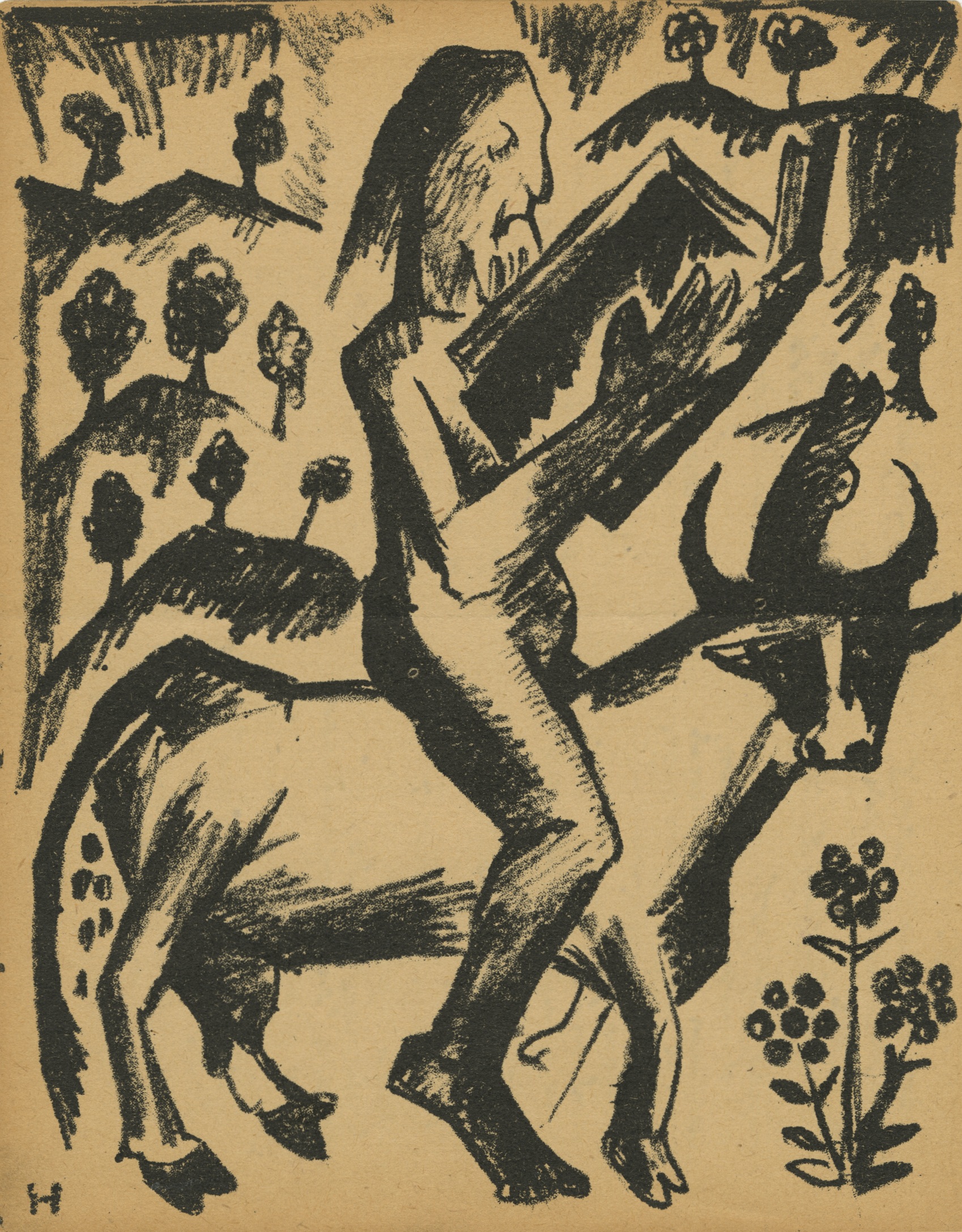 Artist: Natalia Goncharova (July 3, 1881 – October 17, 1962). Russian/French. Lithographic illustration "An elder astride a bull" for Aleksei Kruchenykh book "Two poems. The Hermit. The Hermitess", Moscow, Kuzmin and Dolinsky Publishers, 1913. This sheet is from the book "Natalia Goncharova / Mikhail Larionov" by Eli Eganbyuri (pen-name of Ilia Zdanevich), published by Z. A. Münster in 1913. Inscription on the back: hand-written copy (allegedly by the hand of Osip Brik) of Vladimir Mayakovsky verses for "Red Pepper" (Krasny peretz) magazine issue of 1924, included in the compilation "Ferocious laugh" (Grozny smekh) that was published after Mayakovsky death in 1931. Text of the manuscript on verso. Size: 18,5 х 14,3 cm. Наталия Гончарова (3 июля 1881 – 17 октября 1962). Россия/Франция. Автолитография "Старец верхом на быке" для книги А. Е. Крученых "Две поэмы. Пустынники. Пустынница"; - М.: Изд. Г.Л. Кузьмина, С.Д. Долинского, 1913. Данный лист из книги Эли Эганбюри (псевдоним Ильи Зданевича) "Наталия Гончарова / Михаил Ларионов"; - М. : Изд. Ц. Мюнстера, 1913. На обороте список стихов из подписей к "Красному перцу" 1924 г., которые вошли в сб. "Грозный смех" (вышел после смерти Маяковского в 1931). Вероятно список сделан рукой Осипа Брика. Текст манускрипта. Формат: 18,5 х 14,3 см.
Artist: Natalia Goncharova (July 3, 1881 – October 17, 1962). Russian/French. Lithographic illustration "An elder astride a bull" for Aleksei Kruchenykh book "Two poems. The Hermit. The Hermitess", Moscow, Kuzmin and Dolinsky Publishers, 1913. This sheet is from the book "Natalia Goncharova / Mikhail Larionov" by Eli Eganbyuri (pen-name of Ilia Zdanevich), published by Z. A. Münster in 1913. Inscription on the back: hand-written copy (allegedly by the hand of Osip Brik) of Vladimir Mayakovsky verses for "Red Pepper" (Krasny peretz) magazine issue of 1924, included in the compilation "Ferocious laugh" (Grozny smekh) that was published after Mayakovsky death in 1931. Text of the manuscript on verso. Size: 18,5 х 14,3 cm. Наталия Гончарова (3 июля 1881 – 17 октября 1962). Россия/Франция. Автолитография "Старец верхом на быке" для книги А. Е. Крученых "Две поэмы. Пустынники. Пустынница"; - М.: Изд. Г.Л. Кузьмина, С.Д. Долинского, 1913. Данный лист из книги Эли Эганбюри (псевдоним Ильи Зданевича) "Наталия Гончарова / Михаил Ларионов"; - М. : Изд. Ц. Мюнстера, 1913. На обороте список стихов из подписей к "Красному перцу" 1924 г., которые вошли в сб. "Грозный смех" (вышел после смерти Маяковского в 1931). Вероятно список сделан рукой Осипа Брика. Текст манускрипта. Формат: 18,5 х 14,3 см. -

Copper tsuba of oval form carved in kebori and katakiribori with Tekkai Sennin sitting under bamboo on the face and with a pine tree on the back. Ishime-ji treated surface.
Signed on the reverse: Jōi (乗 意).
Edo period (First half of 18th century). Dimensions: 69.6 x 66.5 x 4.5 mm Sugiura Jōi (杉 浦 乗 意) was a master of Nara School in Edo; he was a student of Toshinaga [M. Sesko, 'Genealogies', p. 32]. "Sugiura Jōi (1701-1761) made many fuchigashira and kozuka, tsuba are rather rare." [M. Sesko, The Japanese toso-kinko Schools]. -

Copper tsuba of slightly elongated round form carved in low relief (shishiaibori and sukisagebori) and inlaid in gold, silver and shakudō with the design of dreaming Rosei (Lu Sheng): he is half-sitting by the pillow with his eyes closed, holding his fan, with a scroll by his feet, surrounded by flying butterflies.
Edo period, first half of the 18th century.
Dimensions: 70.8 x 67.1 x 5.0 mm. Signed on the reverse: Jōi (乗 意) + Kaō. Sugiura Jōi [杉 浦 乗 意] (1701-1761) was a master of Nara School in Edo; he was a student of Toshinaga [M. Sesko, ‘Genealogies’, p. 32]. “Sugiura Jōi (1701-1761) made many fuchigashira and kozuka, tsuba are rather rare.” [M. Sesko, The Japanese toso-kinko Schools, pp. 148-149]. On Rosei (Lu Sheng) dream's legend see Legend in Japanese Art by Henri L. Joly (1908 edition) on page 293. -
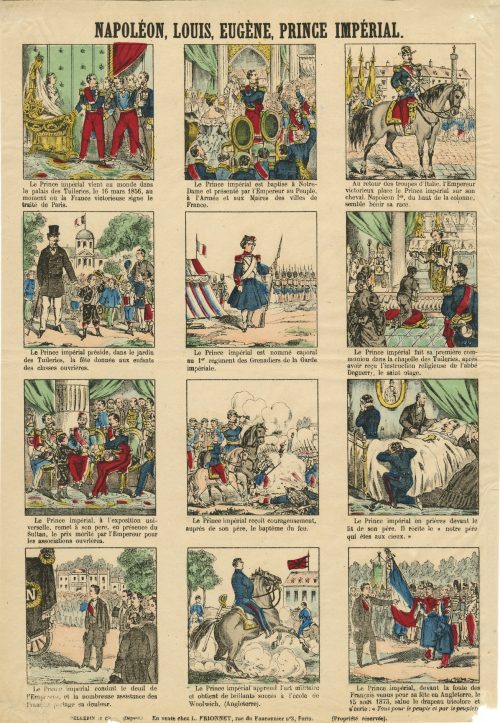 Hand-coloured woodcut on wove paper, 400 x 277 mm. Top: "NAPOLÉON, LOUIS, EUGÈNE, PRINCE IMPÉRIAL"; bellow 12 captioned frames:
Hand-coloured woodcut on wove paper, 400 x 277 mm. Top: "NAPOLÉON, LOUIS, EUGÈNE, PRINCE IMPÉRIAL"; bellow 12 captioned frames:- Le Prince impérial vient au monde dans le palais des Tuileries, le 16 mars 1856, au moment où la France victorieuse signe le traité de Paris.
- Le Prince impérial est baptisé à Notre-Dame et présenté par l'Empereur au Peuple, à l’Armée et aux Maires des villes de France.
- Au retour des troupes d'Italie, l'Empereur victorieux place le Prince impérial sur son cheval. Napoléon Ier, du haut de la colonne, semble bénir sa race.
- Le Prince impérial préside, dans le jardin des Tuileries, la fête donnée aux enfants des classes ouvrières.
- Le Prince impérial est nommé caporal au 1er régiment des Grenadiers de la Garde impériale.
- Le Prince impérial fait sa première communion dans la chapelle des Tuileries, après avoir reçu l'instruction religieuse de l'abbé Deguerry, le saint otage.
- Le Prince impérial, à l'exposition universelle, remet à son père. en présence du Sultan, le prix mérité par l'Empereur pour les associations ouvrières.
- Le Prince impérial reçoit courageusement, auprès de son père, le baptême du feu.
- Le Prince impérial en prières devant le lit de son père. Il récite le « notre père qui ètes aux cieux. »
- Le Prince impérial conduit le deuil de l'Empereur, et la nombreuse assistance des Français portage sa douleur.
- Le Prince impérial apprend l’art militaire et obtient de brillants succès à l'écolo de Woolwich, (Angleterre).
- Le Prince impérial, devant la foule des Français venus pour sa fête en Angleterre, le 15 out 1873, salue le drapeau tricolore et s'écrie : « Tout pour le peuple et par le peuple… »
-
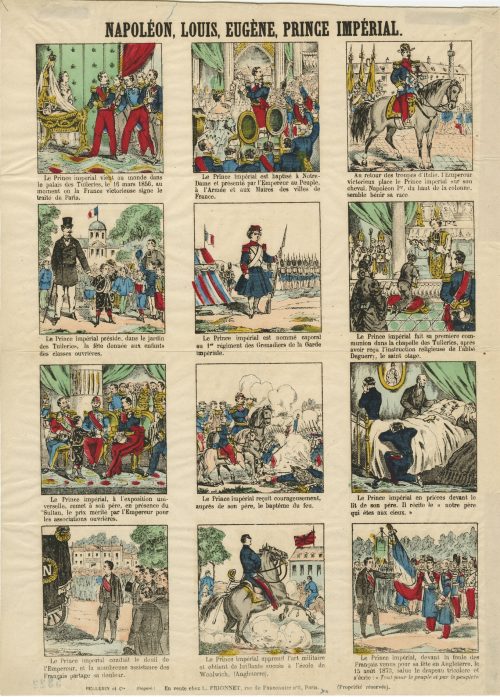 Another copy of SVFC-0745-3.2023, 395 x 290 mm; black ink stamp “5322” to reverse. Jean Charles Pellerin (French, 1756 – 1836)
Another copy of SVFC-0745-3.2023, 395 x 290 mm; black ink stamp “5322” to reverse. Jean Charles Pellerin (French, 1756 – 1836) -
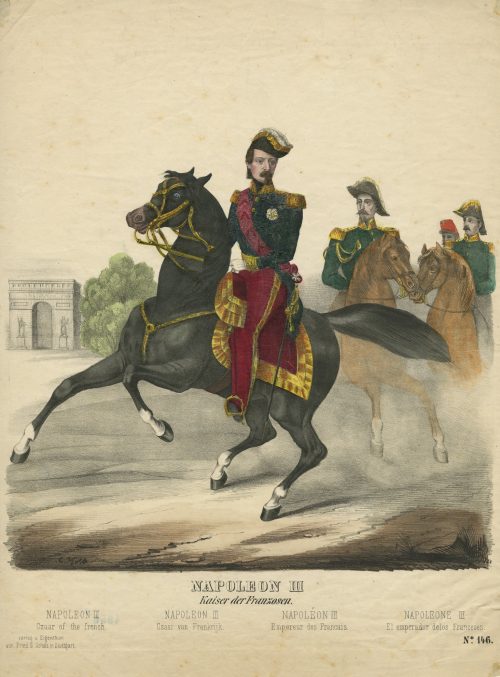 Hand-coloured lithography on wove paper 423 x 332 mm; On reverse: black ink stamp “4956”, ms “A”, ms pencil “428” and “Ernest”. Under the image, centre: "NAPOLEON III | Kaiser der Franzosen." Velow: | NAPOLEON III | Czaar of the French — NAPOLEON III | Czaar van Frankrijk — NAPOLÉON III | Empereur des Francais. — NAPOLEONE III | El emperador delos Franceses; bottom left: "Verlag u. Eigenthum | von. Fried. G. Schulz in Stuttgart.", right: "No 146." The artist's and printer's names in stone are not legible. Published in Stuttgart by Friederich Gustav Schulz (German, 1786 – 1859) during the time of the Second French Empire (1852-1870).
Hand-coloured lithography on wove paper 423 x 332 mm; On reverse: black ink stamp “4956”, ms “A”, ms pencil “428” and “Ernest”. Under the image, centre: "NAPOLEON III | Kaiser der Franzosen." Velow: | NAPOLEON III | Czaar of the French — NAPOLEON III | Czaar van Frankrijk — NAPOLÉON III | Empereur des Francais. — NAPOLEONE III | El emperador delos Franceses; bottom left: "Verlag u. Eigenthum | von. Fried. G. Schulz in Stuttgart.", right: "No 146." The artist's and printer's names in stone are not legible. Published in Stuttgart by Friederich Gustav Schulz (German, 1786 – 1859) during the time of the Second French Empire (1852-1870). -
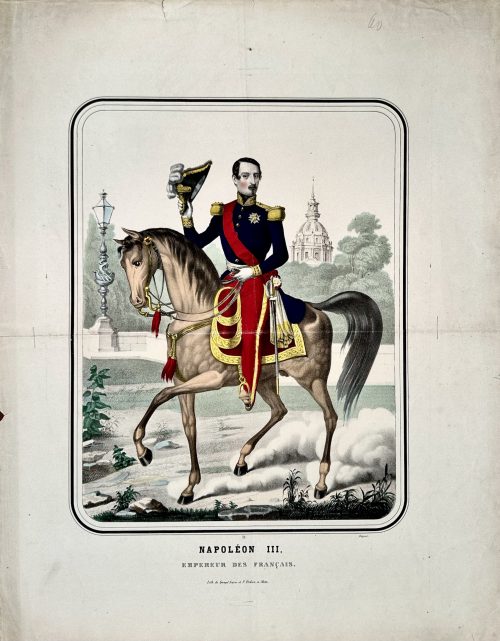 Hand-coloured chromolithography on wove paper, 600 x 470 mm; black ink stamp “4921” to reverse, horizontal and vertical centrefolds. Image of Napoléon III on horseback, in a frame; lettering under the frame: 34 — Déposé | NAPOLÉON III | EMPEREUR DES FRANÇAIS. | Lith. de Gangel frères et P. Didion, à Metz. || Gangel frères et P. Didion (Metz) – printer/publisher. Paulin Didion (French, 1831 – 1879)
Hand-coloured chromolithography on wove paper, 600 x 470 mm; black ink stamp “4921” to reverse, horizontal and vertical centrefolds. Image of Napoléon III on horseback, in a frame; lettering under the frame: 34 — Déposé | NAPOLÉON III | EMPEREUR DES FRANÇAIS. | Lith. de Gangel frères et P. Didion, à Metz. || Gangel frères et P. Didion (Metz) – printer/publisher. Paulin Didion (French, 1831 – 1879) -
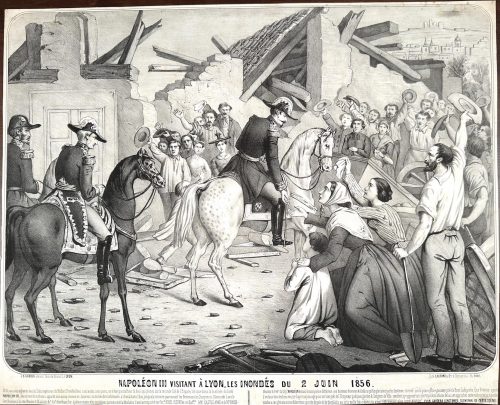 Lithography poster on wove paper, 492 x 614 mm; black ink stamp “5036” to reverse, vertical centerfold. Image in frame; under the frame left: "J. B. Gadola, éditeur. Cours de Brosses 1, à LYON."; right: "Lith LAURANT & Cie r. de Bernardins 34, Paris." Title and text below the image. Jean-Baptiste Gadola (French, 1818 – 1870) – publisher.
Lithography poster on wove paper, 492 x 614 mm; black ink stamp “5036” to reverse, vertical centerfold. Image in frame; under the frame left: "J. B. Gadola, éditeur. Cours de Brosses 1, à LYON."; right: "Lith LAURANT & Cie r. de Bernardins 34, Paris." Title and text below the image. Jean-Baptiste Gadola (French, 1818 – 1870) – publisher. -
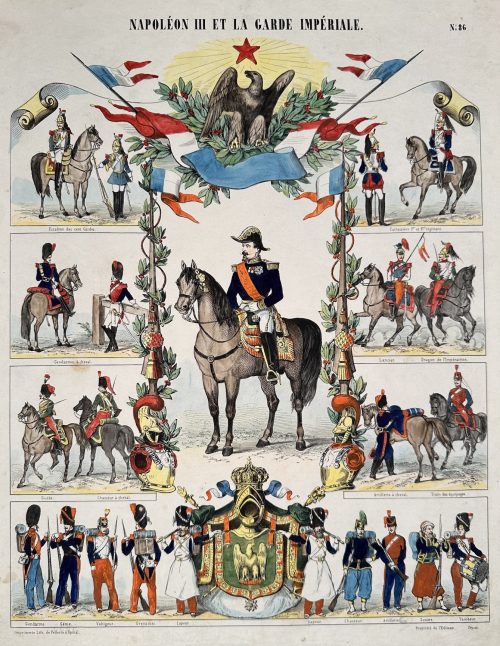 Hand-coloured woodcut on wove paper, 460 x 356 mm; black ink stamp “5055” to reverse. Top centre: "NAPOLÉON III ET LA GARDE IMPÉRIALE"; right: "№ 86". Napoléon III ahorseback in middle, beside (top to bottom): Escadron des cent Gardes — Cuirassiers 1er et 2me regiment; Gendarmes à cheval. — Lancier., Dragon de l’Impératrice.; Guide., Chasseur à cheval. — Artillerie à cheval, Train des équipages.; Gendarme. Génie. Voltigeur. Grenadier. Sapeur. Sapeur. Chasseur. Artillerie. Zouave. Tambour. Bottom left: Imprimerie Lith. de Pellerin à Épinal; right: Propriété de l’Éditeur. Déposé. Jean Charles Pellerin (French, 1756 – 1836) – printer/publisher.
Hand-coloured woodcut on wove paper, 460 x 356 mm; black ink stamp “5055” to reverse. Top centre: "NAPOLÉON III ET LA GARDE IMPÉRIALE"; right: "№ 86". Napoléon III ahorseback in middle, beside (top to bottom): Escadron des cent Gardes — Cuirassiers 1er et 2me regiment; Gendarmes à cheval. — Lancier., Dragon de l’Impératrice.; Guide., Chasseur à cheval. — Artillerie à cheval, Train des équipages.; Gendarme. Génie. Voltigeur. Grenadier. Sapeur. Sapeur. Chasseur. Artillerie. Zouave. Tambour. Bottom left: Imprimerie Lith. de Pellerin à Épinal; right: Propriété de l’Éditeur. Déposé. Jean Charles Pellerin (French, 1756 – 1836) – printer/publisher. -
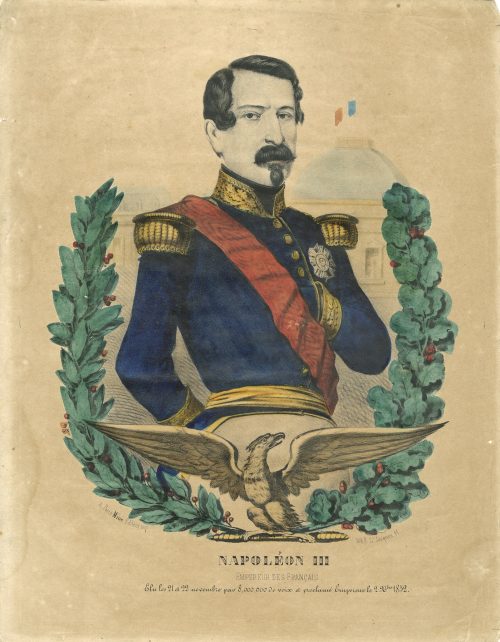 Hand-coloured lithography on wove paper, 380 x 298 mm; black ink stamp “4912” to reverse. On stone left: "A, Paris Miné Éditeur, imp.;" right: "Lith. R. St. Jacques. 41." Bottom center: "Napoléon III"; below: "EMPEREUR DES FRANÇAIS", under: "Élu les 21 el 22 novembre par 8,000,000 de voix et proclamé Empereur le 2 Xbre 1852." Printer/publisher: Miné, éditeur, imprimeur en lithographie, Rue Saint-Jacques, 41. Napoleon III [Charles-Louis Napoléon Bonaparte] (French, 1808 – 1873)
Hand-coloured lithography on wove paper, 380 x 298 mm; black ink stamp “4912” to reverse. On stone left: "A, Paris Miné Éditeur, imp.;" right: "Lith. R. St. Jacques. 41." Bottom center: "Napoléon III"; below: "EMPEREUR DES FRANÇAIS", under: "Élu les 21 el 22 novembre par 8,000,000 de voix et proclamé Empereur le 2 Xbre 1852." Printer/publisher: Miné, éditeur, imprimeur en lithographie, Rue Saint-Jacques, 41. Napoleon III [Charles-Louis Napoléon Bonaparte] (French, 1808 – 1873) -
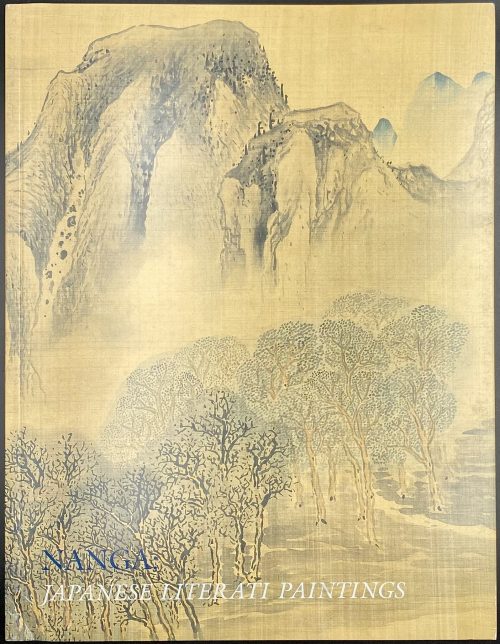 Softcover, in pictorial flapped wrappers, 28 x 21.6 cm, 21 entries, with colour illustrations. Catalogue # 10 of the sales exhibition on March 30 - April 6, 2005 in NY; pagination: [1-3] 4-50 [2], ils. Contributor: Sebastian Izzard
Softcover, in pictorial flapped wrappers, 28 x 21.6 cm, 21 entries, with colour illustrations. Catalogue # 10 of the sales exhibition on March 30 - April 6, 2005 in NY; pagination: [1-3] 4-50 [2], ils. Contributor: Sebastian Izzard -
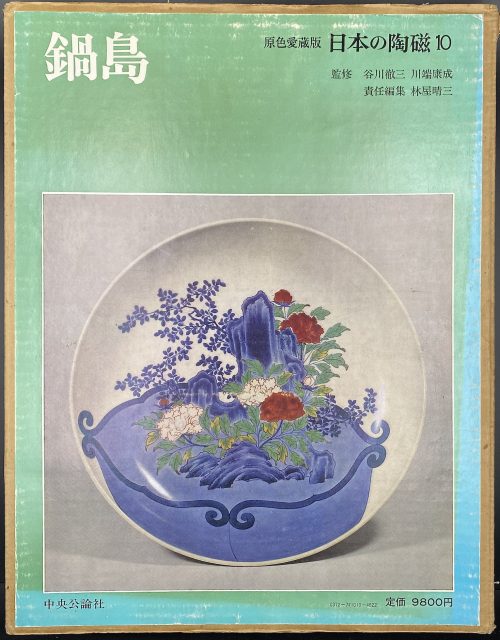 Hardcover volume, 35 x 26.8 cm, bound in grey cloth, blind stamped characters to front, brown characters to spine, in a double slipcase, the outer case pictorial paper over cardboard, 36 x 28.2 cm, pp.: [4] [1] 2-144 (plates with photographs of 332 items), [2] 147-182 [4]. 鍋島 – Nabeshima – book title. 日本の陶磁 – Japanese ceramics, series title. Contributors: Yasunari Kawabata [川端 康成] (Japanese, 1924 – 1972) – author. Tetsuzo Tanikawa [谷川 徹三] (Japanese, 1895 – 1989) – author. Seizo Hayashiya [林屋晴三] (Japanese, 1928 – 2017) – editor. Chūōkōron-sha [中央公論社] – publisher.
Hardcover volume, 35 x 26.8 cm, bound in grey cloth, blind stamped characters to front, brown characters to spine, in a double slipcase, the outer case pictorial paper over cardboard, 36 x 28.2 cm, pp.: [4] [1] 2-144 (plates with photographs of 332 items), [2] 147-182 [4]. 鍋島 – Nabeshima – book title. 日本の陶磁 – Japanese ceramics, series title. Contributors: Yasunari Kawabata [川端 康成] (Japanese, 1924 – 1972) – author. Tetsuzo Tanikawa [谷川 徹三] (Japanese, 1895 – 1989) – author. Seizo Hayashiya [林屋晴三] (Japanese, 1928 – 2017) – editor. Chūōkōron-sha [中央公論社] – publisher. -
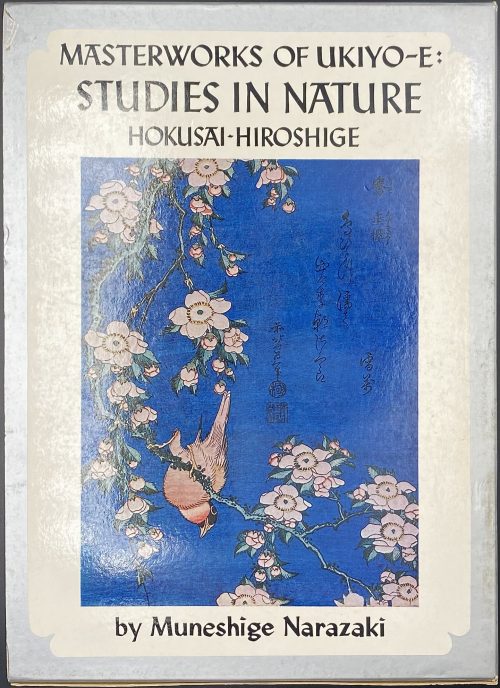 Hardcover volume from the series Masterworks of ukiyo-e, 26.3 x 19.2 cm, bound in unprimed canvas, red characters on black strip to front, red and black lettering to spine, tan flat endpapers, in a pictorial slipcase with series design (black lettering on silver spine); pp: [1-6]: h.t./frontis. (colour plate pasted in), t.p./imprint, contents/acknowledgements), 7-31 text, [32] blank, 33-96 (58 plates w/captions). Title-page (in frame): MASTERWORKS OF UKIYO-E | STUDIES IN NATURE | HOKUSAI-HIROSHIGE | by Muneshige Narazaki | Translated by John Bester | {publisher’s device} | KODANSHA INTERNATIONAL LTD. | Tokyo, Japan & Palo-Alto, Calif., U.S.A | {vertical, between rules 花鳥風月} || 花鳥風月 (Kachou Fugetsu) – beauties of nature. Series: Masterworks of ukiyo-e, № 11. Contributors: Muneshige Narazaki [楢崎 宗重] (Japanese, 1904 – 2001) – author. John Bester (British, 1927 – 2010) – translator. Katsushika Hokusai [葛飾 北斎] (Japanese, 1760 – 1849) – artist. Utagawa Hiroshige [歌川 広重] a.k.a. Andō Hiroshige [安藤 広重] (Japanese, 1797 – 1858) – artist.
Hardcover volume from the series Masterworks of ukiyo-e, 26.3 x 19.2 cm, bound in unprimed canvas, red characters on black strip to front, red and black lettering to spine, tan flat endpapers, in a pictorial slipcase with series design (black lettering on silver spine); pp: [1-6]: h.t./frontis. (colour plate pasted in), t.p./imprint, contents/acknowledgements), 7-31 text, [32] blank, 33-96 (58 plates w/captions). Title-page (in frame): MASTERWORKS OF UKIYO-E | STUDIES IN NATURE | HOKUSAI-HIROSHIGE | by Muneshige Narazaki | Translated by John Bester | {publisher’s device} | KODANSHA INTERNATIONAL LTD. | Tokyo, Japan & Palo-Alto, Calif., U.S.A | {vertical, between rules 花鳥風月} || 花鳥風月 (Kachou Fugetsu) – beauties of nature. Series: Masterworks of ukiyo-e, № 11. Contributors: Muneshige Narazaki [楢崎 宗重] (Japanese, 1904 – 2001) – author. John Bester (British, 1927 – 2010) – translator. Katsushika Hokusai [葛飾 北斎] (Japanese, 1760 – 1849) – artist. Utagawa Hiroshige [歌川 広重] a.k.a. Andō Hiroshige [安藤 広重] (Japanese, 1797 – 1858) – artist. -
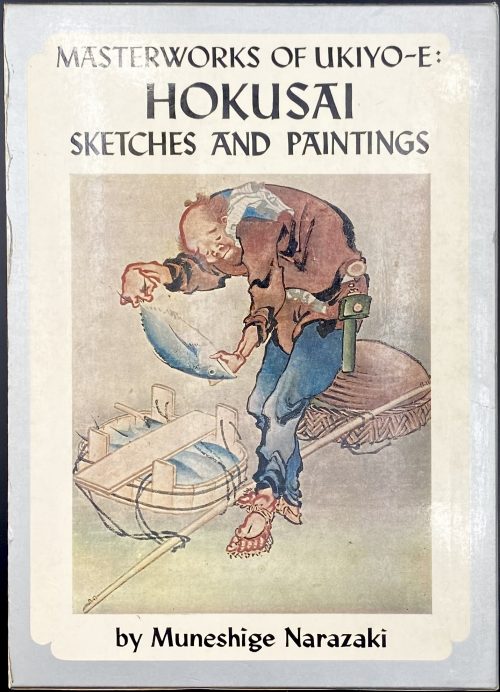 Hardcover volume from the series Masterworks of ukiyo-e, 26.1 x 19 cm, bound in canvas, red characters on black strip to front, red and black lettering to spine, tan embossed endpapers, in a pictorial slipcase with series design (black lettering on silver spine); pp: [1-6]: h.t./frontis. (colour plate pasted in), t.p./imprint, contents/acknowledgements), 7-16 text, 17-96 (79 plates w/captions). Title-page (in frame): MASTERWORKS OF UKIYO-E | HOKUSAI | SKETCHES AND PAINTINGS | by Muneshige Narazaki | English adaptation by John Bester | {publisher’s device} | KODANSHA INTERNATIONAL LTD. | Tokyo, Japan & Palo-Alto, Calif., U.S.A | {vertical, between rules 漫画肉筆画} || Series: Masterworks of ukiyo-e, № 7. Muneshige Narazaki [楢崎 宗重] (Japanese, 1904 – 2001) – author. Katsushika Hokusai [葛飾 北斎] (Japanese, 1760 – 1849) – artist. John Bester (British, 1927 – 2010) – adaptation.
Hardcover volume from the series Masterworks of ukiyo-e, 26.1 x 19 cm, bound in canvas, red characters on black strip to front, red and black lettering to spine, tan embossed endpapers, in a pictorial slipcase with series design (black lettering on silver spine); pp: [1-6]: h.t./frontis. (colour plate pasted in), t.p./imprint, contents/acknowledgements), 7-16 text, 17-96 (79 plates w/captions). Title-page (in frame): MASTERWORKS OF UKIYO-E | HOKUSAI | SKETCHES AND PAINTINGS | by Muneshige Narazaki | English adaptation by John Bester | {publisher’s device} | KODANSHA INTERNATIONAL LTD. | Tokyo, Japan & Palo-Alto, Calif., U.S.A | {vertical, between rules 漫画肉筆画} || Series: Masterworks of ukiyo-e, № 7. Muneshige Narazaki [楢崎 宗重] (Japanese, 1904 – 2001) – author. Katsushika Hokusai [葛飾 北斎] (Japanese, 1760 – 1849) – artist. John Bester (British, 1927 – 2010) – adaptation. -
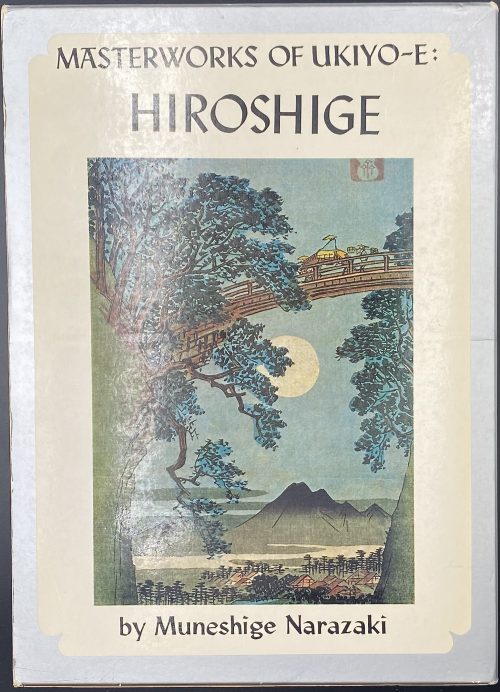 Hardcover volume from the series Masterworks of ukiyo-e, 26.3 x 19 cm, bound in unprimed canvas, red characters on black strip to front, red and black lettering to spine, tan flat endpapers, in a pictorial slipcase with series design (black lettering on silver spine); pp: [1-6]: h.t./frontis. (colour plate pasted in), t.p./imprint, contents/acknowledgements), 7-67 text, 27-30 map, 31-32 f.t./blank, 33-96 (65 plates w/captions). Title-page (in frame): MASTERWORKS OF UKIYO-E | HIROSHIGE | FAMOUS VIEWS | by Muneshige Narazaki | English adaptation by Richard L. Gage | {publisher’s device} | KODANSHA INTERNATIONAL LTD. | Tokyo, Japan & Palo-Alto, Calif., U.S.A | {vertical, between rules in ms 広重]} || Series: Masterworks of ukiyo-e, № 5. Edition: 1st edition ©1968, 2nd printing 1970. Muneshige Narazaki [楢崎 宗重] (Japanese, 1904 – 2001) – author. Utagawa Hiroshige [歌川 広重] a.k.a. Andō Hiroshige [安藤 広重] (Japanese, 1797 – 1858) – artist. Richard L. Gage (American, b. 1934) – adaptation.
Hardcover volume from the series Masterworks of ukiyo-e, 26.3 x 19 cm, bound in unprimed canvas, red characters on black strip to front, red and black lettering to spine, tan flat endpapers, in a pictorial slipcase with series design (black lettering on silver spine); pp: [1-6]: h.t./frontis. (colour plate pasted in), t.p./imprint, contents/acknowledgements), 7-67 text, 27-30 map, 31-32 f.t./blank, 33-96 (65 plates w/captions). Title-page (in frame): MASTERWORKS OF UKIYO-E | HIROSHIGE | FAMOUS VIEWS | by Muneshige Narazaki | English adaptation by Richard L. Gage | {publisher’s device} | KODANSHA INTERNATIONAL LTD. | Tokyo, Japan & Palo-Alto, Calif., U.S.A | {vertical, between rules in ms 広重]} || Series: Masterworks of ukiyo-e, № 5. Edition: 1st edition ©1968, 2nd printing 1970. Muneshige Narazaki [楢崎 宗重] (Japanese, 1904 – 2001) – author. Utagawa Hiroshige [歌川 広重] a.k.a. Andō Hiroshige [安藤 広重] (Japanese, 1797 – 1858) – artist. Richard L. Gage (American, b. 1934) – adaptation. -
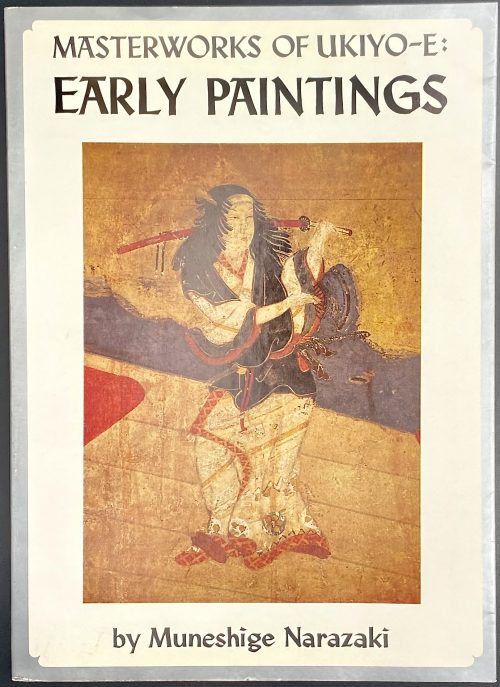 Paperback volume, 25.7 x 18.6 cm, brown embossed wrappers with framed Japanese characters along the outer margin, pictorial dust jacket with series design (black lettering and vignette in silver border to wrappers, black lettering on silver to spine); pp: [1-6]: h.t./frontis. (colour plate pasted in), t.p./imprint, contents/blank), 7-32 text, 33-96 (59 plates w/captions). Title-page (in frame): MASTERWORKS OF UKIYO-E | EARLY PAINTINGS | by Muneshige Narazaki | English adaptation by Charles A. Pomeroy | {publisher’s device} | KODANSHA INTERNATIONAL LTD. | Tokyo, Japan & Palo-Alto, Calif., U.S.A | {vertical between rules 初期 浮世絵} || Series: Masterworks of ukiyo-e, № 1. Contributors: Muneshige Narazaki [楢崎 宗重] (Japanese, 1904 – 2001) – author. Charles A. Pomeroy (American, b. 1930) – adaptation.
Paperback volume, 25.7 x 18.6 cm, brown embossed wrappers with framed Japanese characters along the outer margin, pictorial dust jacket with series design (black lettering and vignette in silver border to wrappers, black lettering on silver to spine); pp: [1-6]: h.t./frontis. (colour plate pasted in), t.p./imprint, contents/blank), 7-32 text, 33-96 (59 plates w/captions). Title-page (in frame): MASTERWORKS OF UKIYO-E | EARLY PAINTINGS | by Muneshige Narazaki | English adaptation by Charles A. Pomeroy | {publisher’s device} | KODANSHA INTERNATIONAL LTD. | Tokyo, Japan & Palo-Alto, Calif., U.S.A | {vertical between rules 初期 浮世絵} || Series: Masterworks of ukiyo-e, № 1. Contributors: Muneshige Narazaki [楢崎 宗重] (Japanese, 1904 – 2001) – author. Charles A. Pomeroy (American, b. 1930) – adaptation. -
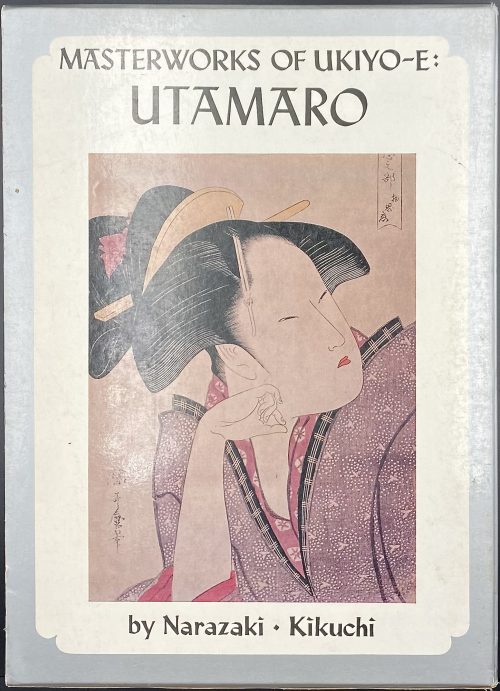 Hardcover volume from the series Masterworks of ukiyo-e, 26.5 x 19 cm, bound in unprimed canvas, red ms characters on black strip to front, red and black lettering to spine, tan embossed endpapers, in a pictorial slipcase with series design (black lettering on silver spine); pp: [1-6]: h.t./frontis. (colour plate pasted in), t.p./imprint, contents/acknowledgements), 7-31 text, [32] blank, 33-96 (76 plates w/captions). Title-page (in frame): MASTERWORKS OF UKIYO-E | UTAMARO | by Muneshige Narazaki and Sadao Kikuchi | Translated by John Bester | {publisher’s device} | KODANSHA INTERNATIONAL LTD. | Tokyo, Japan & Palo-Alto, Calif., U.S.A | {vertical, between rules 歌麿} || Series: Masterworks of ukiyo-e, № 4. Contributors: Muneshige Narazaki [楢崎 宗重] (Japanese, 1904 – 2001) – author. Sadao Kikuchi [菊地 貞雄] (Japanese, 1924 – 2017) – author. John Bester (British, 1927 – 2010) – translator. Kitagawa Utamaro [喜多川 歌麿] (Japanese, c. 1753 – 1806) – artist.
Hardcover volume from the series Masterworks of ukiyo-e, 26.5 x 19 cm, bound in unprimed canvas, red ms characters on black strip to front, red and black lettering to spine, tan embossed endpapers, in a pictorial slipcase with series design (black lettering on silver spine); pp: [1-6]: h.t./frontis. (colour plate pasted in), t.p./imprint, contents/acknowledgements), 7-31 text, [32] blank, 33-96 (76 plates w/captions). Title-page (in frame): MASTERWORKS OF UKIYO-E | UTAMARO | by Muneshige Narazaki and Sadao Kikuchi | Translated by John Bester | {publisher’s device} | KODANSHA INTERNATIONAL LTD. | Tokyo, Japan & Palo-Alto, Calif., U.S.A | {vertical, between rules 歌麿} || Series: Masterworks of ukiyo-e, № 4. Contributors: Muneshige Narazaki [楢崎 宗重] (Japanese, 1904 – 2001) – author. Sadao Kikuchi [菊地 貞雄] (Japanese, 1924 – 2017) – author. John Bester (British, 1927 – 2010) – translator. Kitagawa Utamaro [喜多川 歌麿] (Japanese, c. 1753 – 1806) – artist. -
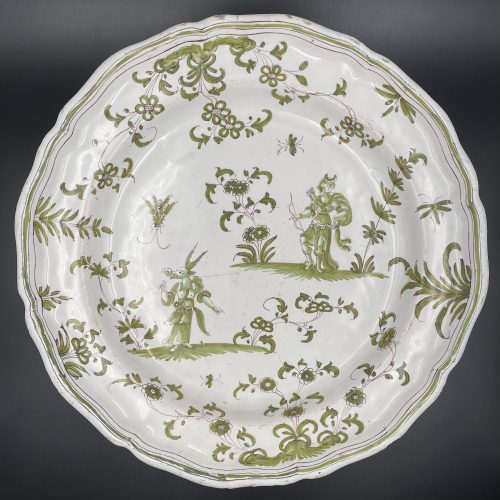 Moustiers faience plate: tin-glazed earthenware plate with a scalloped rim, with green monochrome grotesque decoration of a whimsical creature and a female archer, surrounded by flowering vegetation and insects. Marked "X" on the bottom. "Joseph Fouque/Jean-Francois Pelloquin, started in 1749, used an"X" in its pottery mark". Diameter: 31 cm; Height: 4 cm.
Moustiers faience plate: tin-glazed earthenware plate with a scalloped rim, with green monochrome grotesque decoration of a whimsical creature and a female archer, surrounded by flowering vegetation and insects. Marked "X" on the bottom. "Joseph Fouque/Jean-Francois Pelloquin, started in 1749, used an"X" in its pottery mark". Diameter: 31 cm; Height: 4 cm. -
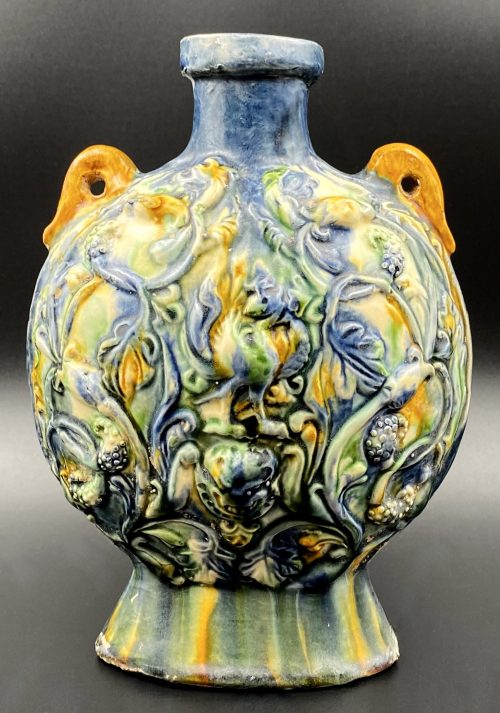 A vessel of flattened ovoid form supported on a tall splayed foot and surmounted by a short neck with the galleried rim. The shoulders set with a pair of loop handles, the body moulded on both sides with a Phenix surrounded with meandering floral and foliate scrolls. Covered with irregular splashes of green, amber, cream, and blue glazes, dripping down the foot. Foot bottom unglazed (beige body). China, the Tang dynasty [唐朝] (618 – 907). Height: 18.5 cm; Width: 13 cm
A vessel of flattened ovoid form supported on a tall splayed foot and surmounted by a short neck with the galleried rim. The shoulders set with a pair of loop handles, the body moulded on both sides with a Phenix surrounded with meandering floral and foliate scrolls. Covered with irregular splashes of green, amber, cream, and blue glazes, dripping down the foot. Foot bottom unglazed (beige body). China, the Tang dynasty [唐朝] (618 – 907). Height: 18.5 cm; Width: 13 cm -
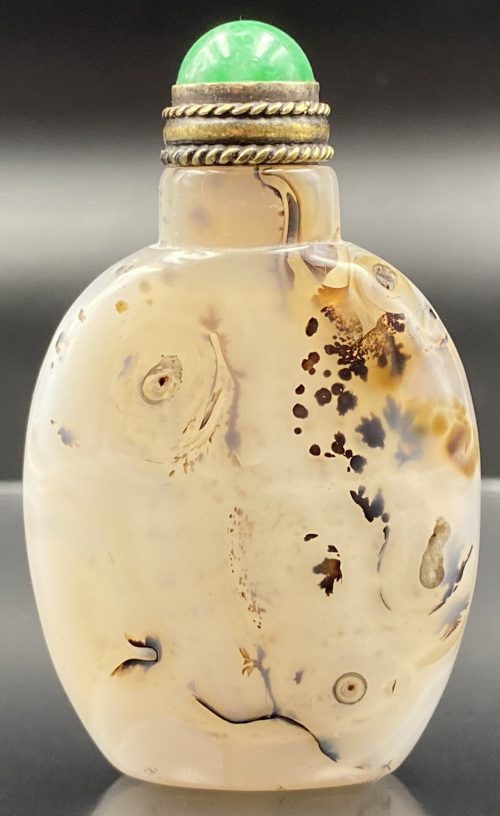 Agate snuff bottle of flattened rounded rectangular form, round neck, and flat base, semitransparent milky white body with dark brown inclusions of geometric form. Green jadeite stopper with a copper alloy spoon and collar. Qing dynasty [清] (1644-1912) Size: 7.2 x 4.3 x 2.2 cm
Agate snuff bottle of flattened rounded rectangular form, round neck, and flat base, semitransparent milky white body with dark brown inclusions of geometric form. Green jadeite stopper with a copper alloy spoon and collar. Qing dynasty [清] (1644-1912) Size: 7.2 x 4.3 x 2.2 cm -
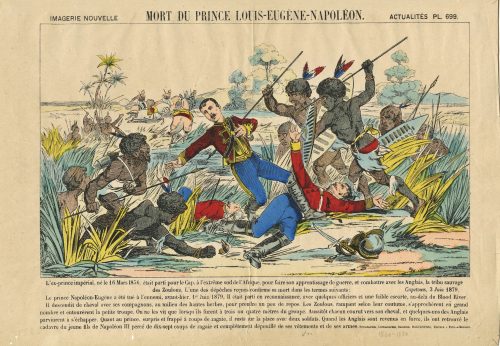 Hand-coloured lithography on wove paper, 275 x 385 mm; vertical centerfold, image in frame. On reverse: black ink stamp “5350”. Above the frame: "IMAGERIE NOUVELLE — MORT DU PRINCE LOUIS-EUGÈNE-NAPOLÉON. — ACTUALITÉS PL. 699". Under the frame: "L'ex-prince impérial, né le 16 Mars I856, était parti pour le Cap, à l'extrême sud de l'Afrique, pour faire son apprentissage de guerre, et combattre avec les Anglais, la tribu sauvage des Zoulous. L'une des dépêches reçues confirme sa mort dans les termes suivants: — Capetown, 3 Juin 1879. — Le prince Napoléon-Eugène a été tué à l'ennemi, avant-hier, 1er Juin 1879, Il était parti en reconnaissance, avec quelques officiers et une fable escorte, au-delà du Blood River. Il descendit de cheval ave ses compagnons, au milieu des hautes herbes, pour prendre un peu de repos. Les Zoulous, rampant selon leur coutume, s'approchèrent en grand nombre et entourèrent la petite troupe. On ne les vit que lorsqu' ils furent à trois ou quatre mètres du groupe. Aussitôt chacun court vers son cheval, et quelques-uns des Anglais parvinrent à s'échapper. Quant au prince, surpris et frappé à coups de zagaie, il resta sur la place avec deux soldats. Quand les Anglais sont revenus en force, ils ont retrouvé le cadavre du jeune fils de Napoléon III percé de dix-sept coups de zagaie et complétement dépouillé de ses vêtements et de ses armes". — "Typographie, Lithographie, Imagerie, Haguenthal, Éditeur à Pont-à-Mousson". Pencil ms: "1860-1880". Élie Haguenthal (French, 1822 – 1881) – publisher/printer.
Hand-coloured lithography on wove paper, 275 x 385 mm; vertical centerfold, image in frame. On reverse: black ink stamp “5350”. Above the frame: "IMAGERIE NOUVELLE — MORT DU PRINCE LOUIS-EUGÈNE-NAPOLÉON. — ACTUALITÉS PL. 699". Under the frame: "L'ex-prince impérial, né le 16 Mars I856, était parti pour le Cap, à l'extrême sud de l'Afrique, pour faire son apprentissage de guerre, et combattre avec les Anglais, la tribu sauvage des Zoulous. L'une des dépêches reçues confirme sa mort dans les termes suivants: — Capetown, 3 Juin 1879. — Le prince Napoléon-Eugène a été tué à l'ennemi, avant-hier, 1er Juin 1879, Il était parti en reconnaissance, avec quelques officiers et une fable escorte, au-delà du Blood River. Il descendit de cheval ave ses compagnons, au milieu des hautes herbes, pour prendre un peu de repos. Les Zoulous, rampant selon leur coutume, s'approchèrent en grand nombre et entourèrent la petite troupe. On ne les vit que lorsqu' ils furent à trois ou quatre mètres du groupe. Aussitôt chacun court vers son cheval, et quelques-uns des Anglais parvinrent à s'échapper. Quant au prince, surpris et frappé à coups de zagaie, il resta sur la place avec deux soldats. Quand les Anglais sont revenus en force, ils ont retrouvé le cadavre du jeune fils de Napoléon III percé de dix-sept coups de zagaie et complétement dépouillé de ses vêtements et de ses armes". — "Typographie, Lithographie, Imagerie, Haguenthal, Éditeur à Pont-à-Mousson". Pencil ms: "1860-1880". Élie Haguenthal (French, 1822 – 1881) – publisher/printer. -
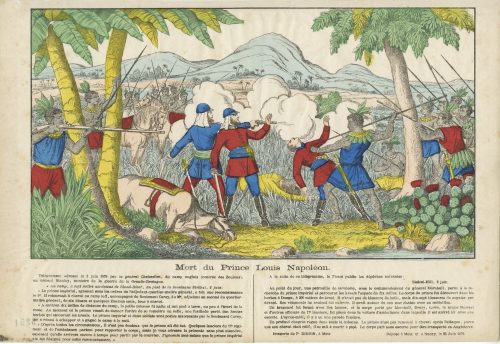 Hand-coloured woodcut on wove paper, 267 x 390 mm. On reverse: black ink stamp “5351”. Centre, under the image frame "Mort du Prince Louis Napoléon". Below left: "Télégramme adressé le 2 juin 1879 par le général Chelmsfort, du camp anglais (contrée des Zoulous), au colonel Stanley, ministre de la guerre de la Grande-Bretagne. « Au camp, à sept milles au-dessus de Blood-River, au pied de la montagne Stellezi, 2 juin: Le prince impérial, agissant sous les ordres de l'adjudant quartier-maitre général. a fait une reconnaissance le 1er. Il retournait à cheval au camp le 2 accompagné du lieutenant Carey, du 98e adjudant en second du quartier-maitre général. de six blancs et, quelques Zoulous amis, tous à cheval. A environ dix milles de distance du camp, la petite colonne fit halte at mit pied à terre, un peu à l’écart de la route. Au moment ou le prince venait de donner l'ordre de se remettre en selle. une fusillade partit des hautes herbes qui entourant les kraals. Le prince impérial et deux soldats sont portés manquants par le lieutenant Carey, qui a réussi à échapper et a gagné le camp à la nuit. D'après toutes les circonstances, il 'est pas douteux quo le prince ait été tué. Quelques lanciers du 17 régiment et de l'ambulance partent pour rapporter le corps; mais je vous adresse la présente sans plus attendre, espérant qu'elle arrivera encore à temps pour partir par le courrier. J’ignorais moi-même que le prince impérial eût été désigné pour cette reconnaissance. »" Below right: A la suite de le télégramme, le Times publie les dépêches suivantes: Stelezi-Hill, 2 juin. Au point du jour, une patrouille de cavalerie, sous le commandement du général Marshall. partit à la recherche du prince impérial et parcourut les kraals l'espace de dix milles. Le corps du prince fut découvert dans les herbes à Donga, à 300 mètres du kraal. Il n'avait pas de blessure de balle, mais dix-sept blessures de zagaies par devant. Ses vêtements lui avaient été enlevés. I avait autour du cou une chaine avec un médaillon. Un brancard fut formé avec les lances, et le corps porté par Marchall, Drury, Lowe, le mjor Stewart et d'autres officiers du 17e lanciers, fut. place dans la voiture d'ambulance dans laquelle il est arrivé ici avec une escorte. L'après-midi, il v a eu une parade funèbre. Un profond chagrin règne dans toute la colonne. Le prince n'est pas remonté à cheval après l’attique, parce que son cheval était rétif ; il se mit à courir à pied. Le corps part sous escorte pour être transporté en Angleterre. Bottom right: "Imagerie de P. DIDION, à Metz — Déposé à Metz et à Nancy, le 25 Juin 1879". Paulin Didion (French, 1831 – 1879) – publisher/printer.
Hand-coloured woodcut on wove paper, 267 x 390 mm. On reverse: black ink stamp “5351”. Centre, under the image frame "Mort du Prince Louis Napoléon". Below left: "Télégramme adressé le 2 juin 1879 par le général Chelmsfort, du camp anglais (contrée des Zoulous), au colonel Stanley, ministre de la guerre de la Grande-Bretagne. « Au camp, à sept milles au-dessus de Blood-River, au pied de la montagne Stellezi, 2 juin: Le prince impérial, agissant sous les ordres de l'adjudant quartier-maitre général. a fait une reconnaissance le 1er. Il retournait à cheval au camp le 2 accompagné du lieutenant Carey, du 98e adjudant en second du quartier-maitre général. de six blancs et, quelques Zoulous amis, tous à cheval. A environ dix milles de distance du camp, la petite colonne fit halte at mit pied à terre, un peu à l’écart de la route. Au moment ou le prince venait de donner l'ordre de se remettre en selle. une fusillade partit des hautes herbes qui entourant les kraals. Le prince impérial et deux soldats sont portés manquants par le lieutenant Carey, qui a réussi à échapper et a gagné le camp à la nuit. D'après toutes les circonstances, il 'est pas douteux quo le prince ait été tué. Quelques lanciers du 17 régiment et de l'ambulance partent pour rapporter le corps; mais je vous adresse la présente sans plus attendre, espérant qu'elle arrivera encore à temps pour partir par le courrier. J’ignorais moi-même que le prince impérial eût été désigné pour cette reconnaissance. »" Below right: A la suite de le télégramme, le Times publie les dépêches suivantes: Stelezi-Hill, 2 juin. Au point du jour, une patrouille de cavalerie, sous le commandement du général Marshall. partit à la recherche du prince impérial et parcourut les kraals l'espace de dix milles. Le corps du prince fut découvert dans les herbes à Donga, à 300 mètres du kraal. Il n'avait pas de blessure de balle, mais dix-sept blessures de zagaies par devant. Ses vêtements lui avaient été enlevés. I avait autour du cou une chaine avec un médaillon. Un brancard fut formé avec les lances, et le corps porté par Marchall, Drury, Lowe, le mjor Stewart et d'autres officiers du 17e lanciers, fut. place dans la voiture d'ambulance dans laquelle il est arrivé ici avec une escorte. L'après-midi, il v a eu une parade funèbre. Un profond chagrin règne dans toute la colonne. Le prince n'est pas remonté à cheval après l’attique, parce que son cheval était rétif ; il se mit à courir à pied. Le corps part sous escorte pour être transporté en Angleterre. Bottom right: "Imagerie de P. DIDION, à Metz — Déposé à Metz et à Nancy, le 25 Juin 1879". Paulin Didion (French, 1831 – 1879) – publisher/printer. -
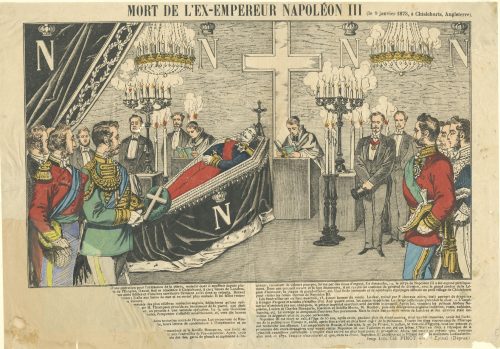 Hand-coloured woodcut on wove paper, 270 x 380 mm; attached to the sheet 303 x 442 mm with pencil ms inscription to the top left corner on the reverse: “Haye le 2-3-75”. Top: "MORT DE L'EX-EMPEREUR NAPOLÉON III (le 9 janvier 1873, à Chislehurts [sic], Angleterre)." Bottom right: "Imp. Lith. CH. PINOT, éditeur. Épinal (Dépose)". Bottom left corner of the image sheet torn and manually restored. Text partially lost, starting with « d’une opération pour l’extraction de la pierre, maladie dont’ il souffrait depuis plu-… ». See Chislehurst. Charles-François Pinot (French, 1817 – 1879) – publisher/printer.
Hand-coloured woodcut on wove paper, 270 x 380 mm; attached to the sheet 303 x 442 mm with pencil ms inscription to the top left corner on the reverse: “Haye le 2-3-75”. Top: "MORT DE L'EX-EMPEREUR NAPOLÉON III (le 9 janvier 1873, à Chislehurts [sic], Angleterre)." Bottom right: "Imp. Lith. CH. PINOT, éditeur. Épinal (Dépose)". Bottom left corner of the image sheet torn and manually restored. Text partially lost, starting with « d’une opération pour l’extraction de la pierre, maladie dont’ il souffrait depuis plu-… ». See Chislehurst. Charles-François Pinot (French, 1817 – 1879) – publisher/printer. -
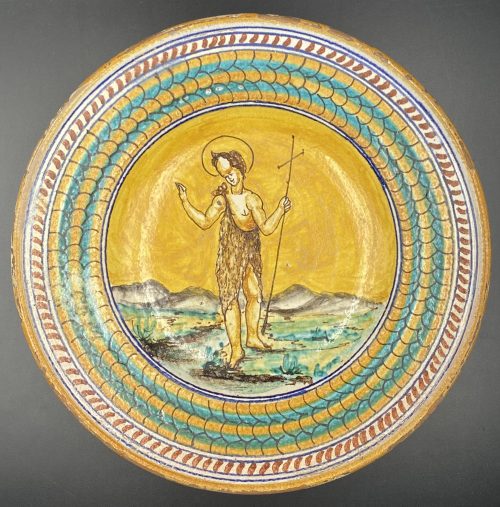 Tin-glazed earthenware polychrome plate of round form, decorated with a figure of John the Baptist wearing clothes of camel's hair with a tall cross in his left hand and with a halo over his head, walking in a desert with hills on the background. The lip is decorated with circles and scales, base with concentric circles. Diameter: 23 cm; Height: 4 cm.
Tin-glazed earthenware polychrome plate of round form, decorated with a figure of John the Baptist wearing clothes of camel's hair with a tall cross in his left hand and with a halo over his head, walking in a desert with hills on the background. The lip is decorated with circles and scales, base with concentric circles. Diameter: 23 cm; Height: 4 cm. -
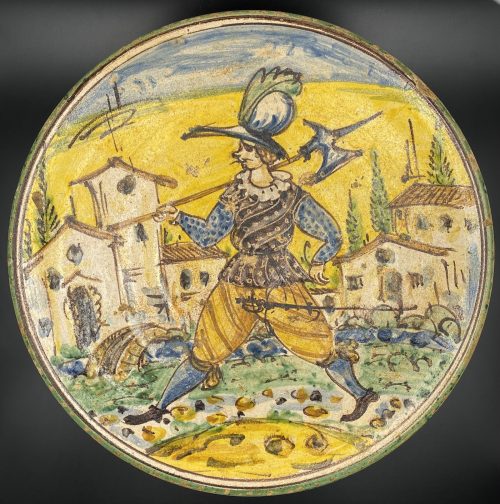 Footed round dish depicting a gentleman in an urban landscape holding a halberd in a style of "Arlecchino di Montelupo". Unsigned. Chips to the bottom. Diameter: 32.5 cm; Height: 4.5 cm. Produced in Italy, in Montelupo, about 20 kilometres (12 miles) southwest of Florence. 17th century, probably the first half. "After 1630, the year of the great plague, the number of potters reduced considerably and in the second half of the 1600s production suffered a drastic slump, potteries that specialized in a more prestigious production disappeared completely leaving only the potteries that produced kitchenware and terracotta objects" [www.tuscany-charming.it].
Footed round dish depicting a gentleman in an urban landscape holding a halberd in a style of "Arlecchino di Montelupo". Unsigned. Chips to the bottom. Diameter: 32.5 cm; Height: 4.5 cm. Produced in Italy, in Montelupo, about 20 kilometres (12 miles) southwest of Florence. 17th century, probably the first half. "After 1630, the year of the great plague, the number of potters reduced considerably and in the second half of the 1600s production suffered a drastic slump, potteries that specialized in a more prestigious production disappeared completely leaving only the potteries that produced kitchenware and terracotta objects" [www.tuscany-charming.it]. -
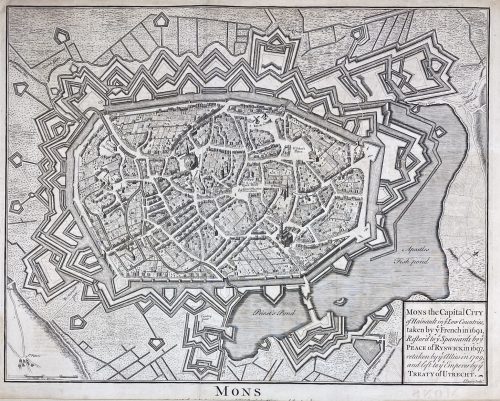
Mons the Capital City of Hainault in y Low Countries, taken by y French in 1691, Restor'd to y Spaniards by y Peace of Ryswick in 1697, retaken by y Allies in 1709, and left to y Emperor by y Treaty of Utrecht. attribution to publication source has been trimmed.
Dimensions: Sheet: 40.7 x 52.5 cm; Image: 37.5 x 48 cm. Published between 1744 and 1747. Attribution to publication source has been trimmed. Reference: Royal Academy 03/2919. Source: Maps for Mr. Tindal's Continuation of Mr. Rapin's History of England. London: John and Paul Knapton. Nicolas Tindal (British, 1687 – 1774) – the translator and continuer of the History of England by Paul de Rapin. Paul de Rapin (French, 1661 – 1725) – a Huguenot historian, author of the History of England. -
 Iron tsuba with brown patina in mokkō-gata form with woven design. Size: 72 x 67 x 5 mm.
Iron tsuba with brown patina in mokkō-gata form with woven design. Size: 72 x 67 x 5 mm. -
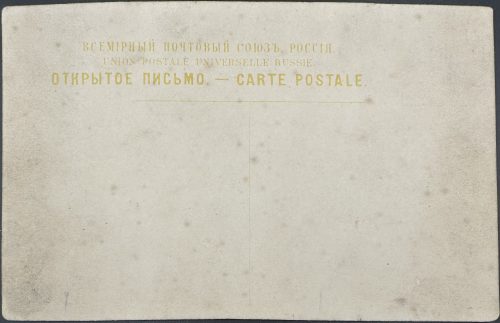 Ten postcards 90 x 140 mm, text in yellow "ВСЕМIРНЫЙ ПОЧТОВЫЙ СОЮЗЪ. РОССIЯ. | UNION POSTALE UNIVERSELLE RUSSIE. | ОТКРЫТОЕ ПИСЬМО. — CARTE POSTALE. || On the reverse, a blue ink woodcut image is printed in the upper left corner, and a идгу штл inscription is in the bottom centre. Holding the postcard against the backlight reveals a hidden image of an indecent nature (erotic). The use of Latin characters "R" and "N" instead of Russian "Р" and "Н" suggests that the cards were produced in Europe, probably in France. Inscriptions: 1. ПЕRВЫЕ ДNИ; 2. ПОRА ЛЮБВИ; 3. ВЪ ЛЮДИ; 4. КЪ "СВОБОДNОМУ ИСКУССТВУ"; 5. "СВОБОДNЫЙ ТRУДЪ; 6. БЕЗЪ ГОRЯ И ПЕЧАЛИ; 7. NАЗАДЪ КЪ "СВОБОДNОЙ ЛЮБВИ"; 8. ВСЕ ЧТО ОСТАЛОСЬ!; 9. БЕЗЪ КRОВА И ПRИСТАNИЩА; 10. ИЗЪ ЗА ХЛѢБА.
Ten postcards 90 x 140 mm, text in yellow "ВСЕМIРНЫЙ ПОЧТОВЫЙ СОЮЗЪ. РОССIЯ. | UNION POSTALE UNIVERSELLE RUSSIE. | ОТКРЫТОЕ ПИСЬМО. — CARTE POSTALE. || On the reverse, a blue ink woodcut image is printed in the upper left corner, and a идгу штл inscription is in the bottom centre. Holding the postcard against the backlight reveals a hidden image of an indecent nature (erotic). The use of Latin characters "R" and "N" instead of Russian "Р" and "Н" suggests that the cards were produced in Europe, probably in France. Inscriptions: 1. ПЕRВЫЕ ДNИ; 2. ПОRА ЛЮБВИ; 3. ВЪ ЛЮДИ; 4. КЪ "СВОБОДNОМУ ИСКУССТВУ"; 5. "СВОБОДNЫЙ ТRУДЪ; 6. БЕЗЪ ГОRЯ И ПЕЧАЛИ; 7. NАЗАДЪ КЪ "СВОБОДNОЙ ЛЮБВИ"; 8. ВСЕ ЧТО ОСТАЛОСЬ!; 9. БЕЗЪ КRОВА И ПRИСТАNИЩА; 10. ИЗЪ ЗА ХЛѢБА. -
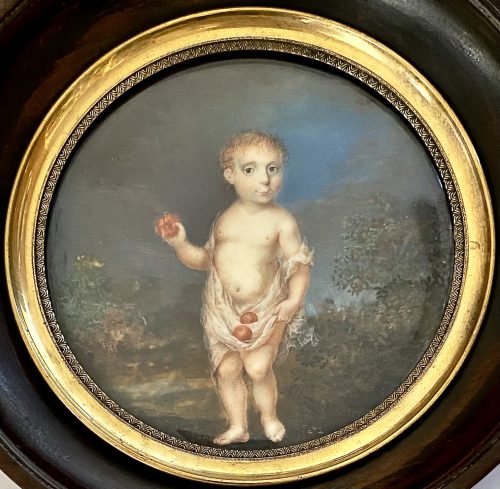 Round portrait of a little girl (22-month-old) with bright black eyes and red hair, draped in a semi-transparent shirt which leaves her chest and stomach bare, keeping a red apple in her right hand and two others lying in the fold of her clothes, standing against a dark natural background: bushes, leaves, an apple tree, blue skies, clouds, etc. Oil on metal; in an ormolu frame, in a wooden frame. Diameter without frames 8 cm, with frames – 12.6 cm. Sitter: Courtois, Fortunée-Florentine Elisabeth (French, August 23, 1800 г. – after 1878). Inscription (handwriting, nut ink): Fortunée, Florentine Elisabeth | Courtois a 22 mois. | née 5e fructidor an 8 || Attributed to Lié Louis Périn-Salbreux (French, 1753 – 1817). Fortunée-Florentine Elisabeth Courtois is a mother of Maurice Joly (French, 1829 – 1878). See also in this collection: blog, LIB-0460, blog, LIB-1038.2016, and Une Épave de l’Ancien Bateau by Tout-Paris. A Lost Article by Proust? The portrait was sold at Drouot (Paris) in 2020 with the following description: "École FRANÇAISE de la fin du XVIIIe siècle Fortunée Florentine Courtois enfant en chemise, en pied dans la nature, tenant trois pommes. Miniature sur ivoire, identifiée au revers : « Florentine Fortunée Elisabeth / Courtois à 22 mois / le 5e ( ?) Fructidor an VIII » [août 1800]; Diam. à vue : 7 cm; Cadre rond en bois tourné et noirci. Florentine Courtois, fille d’André et d’Elisabeth Corbara, épousa vers 1818 Lambert Philippe Joly, conseiller général du Jura, avocat ; leur fils Maurice Joly, avocat, fut ministre de la Justice du gouvernement provisoire en 1870 et grand maître du Grand Orient de France". Maurice Joly was a lawyer, but nothing else in his description given by Drouot is true. From this inscription, we learned that Fortunée-Florentine Elisabeth Courtois was born on August 23, 1800. We were unable to verify this from any other source. From Morice Joly autobiography (Maurice Joly, son passé, son programme par lui-même. — Paris, Lacroix, Verbœckoven et Ce, 1870) we know that she was born in Bastia and that her father, Laurent Courtois (in some sources André François Désiré Courtois, born c. 1771), was a treasurer of Corsican troops under Napoleon Bonapart. Her mother was Elisabeth Marie-Grâcieuse Corbara (born c. 1750).
Round portrait of a little girl (22-month-old) with bright black eyes and red hair, draped in a semi-transparent shirt which leaves her chest and stomach bare, keeping a red apple in her right hand and two others lying in the fold of her clothes, standing against a dark natural background: bushes, leaves, an apple tree, blue skies, clouds, etc. Oil on metal; in an ormolu frame, in a wooden frame. Diameter without frames 8 cm, with frames – 12.6 cm. Sitter: Courtois, Fortunée-Florentine Elisabeth (French, August 23, 1800 г. – after 1878). Inscription (handwriting, nut ink): Fortunée, Florentine Elisabeth | Courtois a 22 mois. | née 5e fructidor an 8 || Attributed to Lié Louis Périn-Salbreux (French, 1753 – 1817). Fortunée-Florentine Elisabeth Courtois is a mother of Maurice Joly (French, 1829 – 1878). See also in this collection: blog, LIB-0460, blog, LIB-1038.2016, and Une Épave de l’Ancien Bateau by Tout-Paris. A Lost Article by Proust? The portrait was sold at Drouot (Paris) in 2020 with the following description: "École FRANÇAISE de la fin du XVIIIe siècle Fortunée Florentine Courtois enfant en chemise, en pied dans la nature, tenant trois pommes. Miniature sur ivoire, identifiée au revers : « Florentine Fortunée Elisabeth / Courtois à 22 mois / le 5e ( ?) Fructidor an VIII » [août 1800]; Diam. à vue : 7 cm; Cadre rond en bois tourné et noirci. Florentine Courtois, fille d’André et d’Elisabeth Corbara, épousa vers 1818 Lambert Philippe Joly, conseiller général du Jura, avocat ; leur fils Maurice Joly, avocat, fut ministre de la Justice du gouvernement provisoire en 1870 et grand maître du Grand Orient de France". Maurice Joly was a lawyer, but nothing else in his description given by Drouot is true. From this inscription, we learned that Fortunée-Florentine Elisabeth Courtois was born on August 23, 1800. We were unable to verify this from any other source. From Morice Joly autobiography (Maurice Joly, son passé, son programme par lui-même. — Paris, Lacroix, Verbœckoven et Ce, 1870) we know that she was born in Bastia and that her father, Laurent Courtois (in some sources André François Désiré Courtois, born c. 1771), was a treasurer of Corsican troops under Napoleon Bonapart. Her mother was Elisabeth Marie-Grâcieuse Corbara (born c. 1750). -
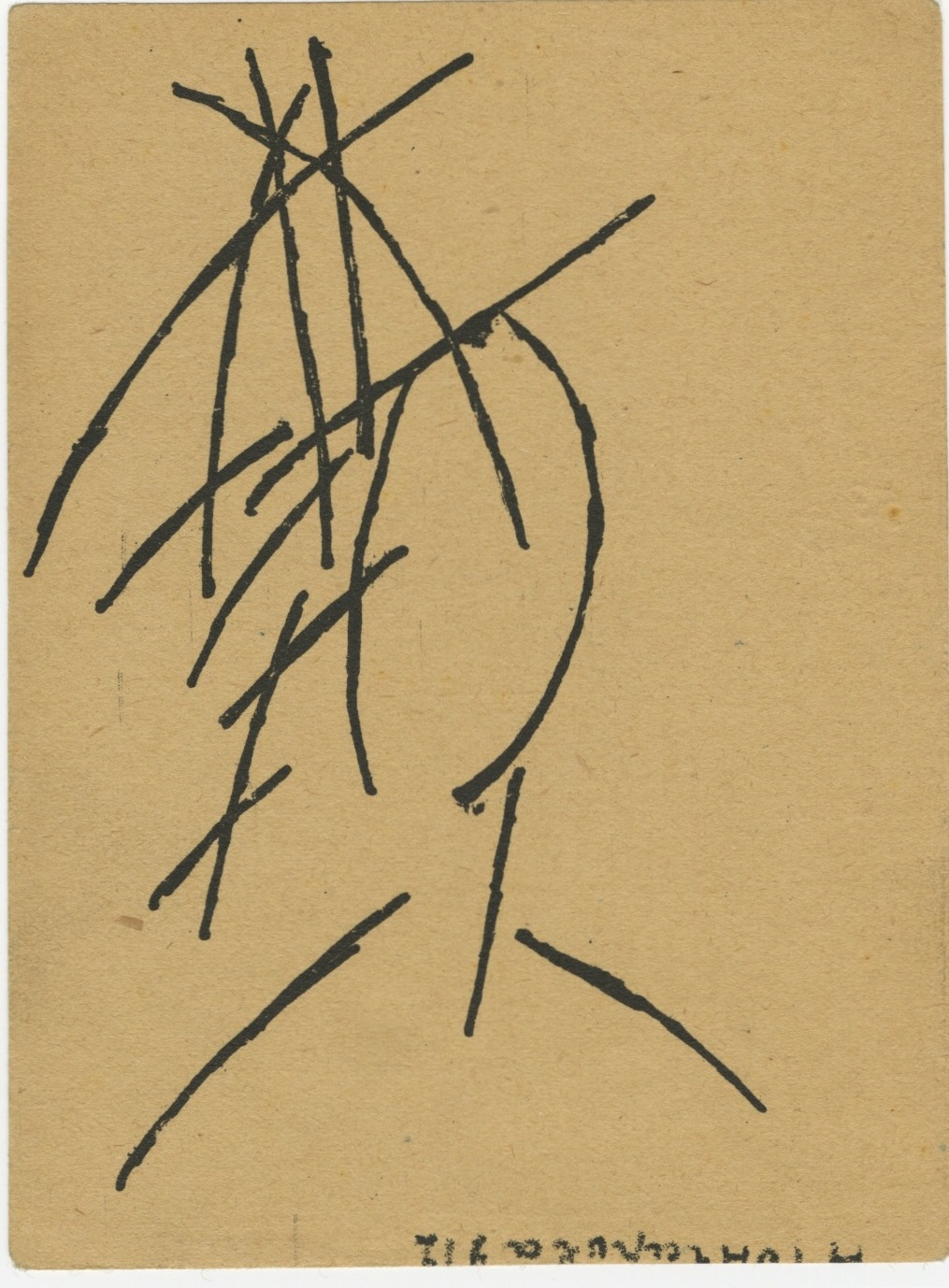 Artist: Mikhail Larionov (June 3, 1881 – May 10, 1964) ). Russian/French. Lithographic illustration "Woman in a hat" for Aleksei Kruchenykh book "Lipstick", Moscow, Kuzmin and Dolinsky Publishers, 1913, 480 copies printed. Size: 11,3 х 8,2 cm. Михаил Ларионов (3 июня 1881 – 10 мая 1964). Россия/Франция. Литографическая иллюстрация "Женщина в шляпе" к книге Алексея Крученых "Помада"; М.: Изд. Г.Л. Кузьмина и С.Д. Долинского, 1913, отпечатана в 480 экз. Формат: 11,3 х 8,2 см.
Artist: Mikhail Larionov (June 3, 1881 – May 10, 1964) ). Russian/French. Lithographic illustration "Woman in a hat" for Aleksei Kruchenykh book "Lipstick", Moscow, Kuzmin and Dolinsky Publishers, 1913, 480 copies printed. Size: 11,3 х 8,2 cm. Михаил Ларионов (3 июня 1881 – 10 мая 1964). Россия/Франция. Литографическая иллюстрация "Женщина в шляпе" к книге Алексея Крученых "Помада"; М.: Изд. Г.Л. Кузьмина и С.Д. Долинского, 1913, отпечатана в 480 экз. Формат: 11,3 х 8,2 см. -
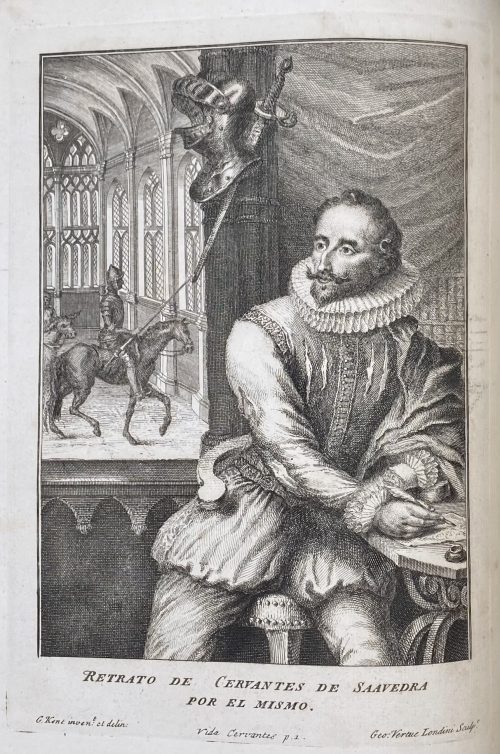 Two volumes uniformly bound by Riviere & Son in full red marbled calf, triple fillet border stamped in gilt, elaborate gilt ornament and brown morocco labels with gilt lettering to spine, all edge gilt, gilt dentelles. Vol. 1: Title page: THE | LIFE AND EXPLOITS | Of the ingenious gentleman | DON QUIXOTE | DE LA MANCHA. | Translated from the Original Spanish of | Miguel Cervantes de Saavedra. | By CHARLES JARVIS, Esq; | IN TWO VOLUMES. | {single rule} | VOLUME the FIRST. | {double rule} | LONDON: | Printed for J. and R. Tonson in the Strand, and | R. Dodsley in Pall-Mall. | {single rule} | M DCC XLII || Pagination: [i-iii] iv-xxxii, [i-iii] iv-vi, [2], [1] 2-90, [14], [1] 2-355 [356]; 500 pages total + ils. Collation: 4to; 250 leaves; A4 a-b4 c-d2, A4, a-l4 m2 n4 o2, B-Z4, Aa-Yy4 Z2, ils. Illustrations: 27 full-page copperplate engravings, incl. frontispiece (skillfully repaired), portrait of Cervantes by George Vertue After G. Kent and a fictional portrait of Don Quixote by George Vertue after John Vanderbank. Vol. 2: Title page: THE | LIFE AND EXPLOITS | Of the ingenious gentleman | DON QUIXOTE | DE LA MANCHA. | Translated from the Original Spanish of | Miguel Cervantes de Saavedra. | By CHARLES JARVIS, Esq; | {single rule} | VOLUME the SECOND. | {double rule} | LONDON: | Printed for J. and R. Tonson in the Strand, and | R. Dodsley in Pall-Mall. | {single rule} | M DCC XLII || Pagination: [i-iii] iv-xii, [1] 2-388; 400 pages total + ils. Collation: 4to; 200 leaves; A4 a2 B-Z4 Aa-Zz4 Aaa-Ccc4 Ddd2, ils. Illustrations:41 full-page copperplate engravings, pl. 29 (as frontispieces) precedes pl. 28. Contributors: Author: Miguel de Cervantes Saavedra (Spanish, 1547 – 1616) Translator: Charles Jervas (British, 1675 – 1739) Author: Cervantes biography by Gregorio Mayans y Siscar (Spanish, 1699 – 1781) Translator: Cervantes biography by John Ozell (British, d. 1743) Illustrator: John Vanderbank, the younger (British, 1694 – 1739) Artist: (Cervantes portrait): G. Kent (British, fl. 1738 – 1742) Engravers: Gerard Vandergucht (British, 1696 – 1776); George Vertue (British, 1684 – 1756); Bernard Baron (French, 1696 – 1762); Claude Du Bosc (French, 1682 – 1746 or later) Publishers: J. and R. Tonson (London); Robert Dodsley (British, 1703 – 1764) Catalogue raisonné: Lewine p. 102 Reference: Metropolitan Museum (New York)
Two volumes uniformly bound by Riviere & Son in full red marbled calf, triple fillet border stamped in gilt, elaborate gilt ornament and brown morocco labels with gilt lettering to spine, all edge gilt, gilt dentelles. Vol. 1: Title page: THE | LIFE AND EXPLOITS | Of the ingenious gentleman | DON QUIXOTE | DE LA MANCHA. | Translated from the Original Spanish of | Miguel Cervantes de Saavedra. | By CHARLES JARVIS, Esq; | IN TWO VOLUMES. | {single rule} | VOLUME the FIRST. | {double rule} | LONDON: | Printed for J. and R. Tonson in the Strand, and | R. Dodsley in Pall-Mall. | {single rule} | M DCC XLII || Pagination: [i-iii] iv-xxxii, [i-iii] iv-vi, [2], [1] 2-90, [14], [1] 2-355 [356]; 500 pages total + ils. Collation: 4to; 250 leaves; A4 a-b4 c-d2, A4, a-l4 m2 n4 o2, B-Z4, Aa-Yy4 Z2, ils. Illustrations: 27 full-page copperplate engravings, incl. frontispiece (skillfully repaired), portrait of Cervantes by George Vertue After G. Kent and a fictional portrait of Don Quixote by George Vertue after John Vanderbank. Vol. 2: Title page: THE | LIFE AND EXPLOITS | Of the ingenious gentleman | DON QUIXOTE | DE LA MANCHA. | Translated from the Original Spanish of | Miguel Cervantes de Saavedra. | By CHARLES JARVIS, Esq; | {single rule} | VOLUME the SECOND. | {double rule} | LONDON: | Printed for J. and R. Tonson in the Strand, and | R. Dodsley in Pall-Mall. | {single rule} | M DCC XLII || Pagination: [i-iii] iv-xii, [1] 2-388; 400 pages total + ils. Collation: 4to; 200 leaves; A4 a2 B-Z4 Aa-Zz4 Aaa-Ccc4 Ddd2, ils. Illustrations:41 full-page copperplate engravings, pl. 29 (as frontispieces) precedes pl. 28. Contributors: Author: Miguel de Cervantes Saavedra (Spanish, 1547 – 1616) Translator: Charles Jervas (British, 1675 – 1739) Author: Cervantes biography by Gregorio Mayans y Siscar (Spanish, 1699 – 1781) Translator: Cervantes biography by John Ozell (British, d. 1743) Illustrator: John Vanderbank, the younger (British, 1694 – 1739) Artist: (Cervantes portrait): G. Kent (British, fl. 1738 – 1742) Engravers: Gerard Vandergucht (British, 1696 – 1776); George Vertue (British, 1684 – 1756); Bernard Baron (French, 1696 – 1762); Claude Du Bosc (French, 1682 – 1746 or later) Publishers: J. and R. Tonson (London); Robert Dodsley (British, 1703 – 1764) Catalogue raisonné: Lewine p. 102 Reference: Metropolitan Museum (New York) -
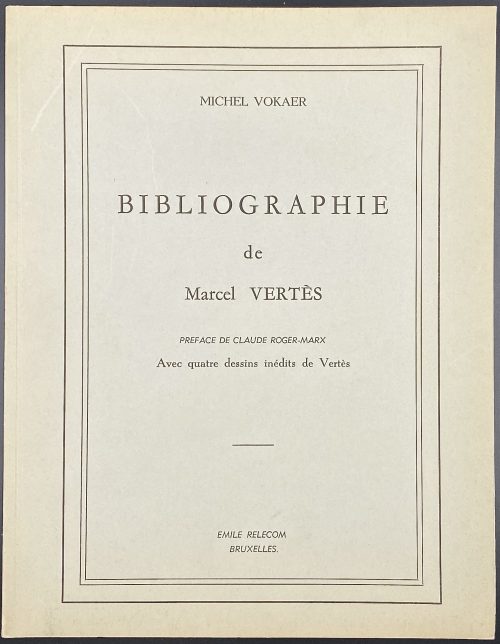 Description: Limited softcover edition in grey publisher’s wrappers 27 x 21 cm, lettered in a frame “MICHEL VOKAER | BIBLIOGRAPHIE | de | Marcel VERTÈS | PREFACE DE CLAUDE ROGER-MARX | Avec quatre dessins inédits de Vertès | — | EMILE RELECOM | BRUXELLES ||, lettered spine, pp. [1-4 h.t., t.p.] 5-34 [35, 36 blanks] [37 limitation] [38 blank] [39 colophon] [40 blank]; 40 pages total plus 4 photomechanical reproductions of Vertès’ unpublished drawings on glossy paper, extraneous to collation. Catalogue of 82 entries. Received uncut. Title-page: similar to front wrapper, plus «1967» in the bottom under BRUXELLES. Limitation: 7 copies (A-G) on Japon chamois + 2 suites of plates, 25 copies (1-25) on Hollande Van Gelder + 1 suite of plates, 450 copies (26-475) on offset Arduenna, and 40 copies not hor sale (I-XL) on different papers. The total print run is 522 copies, of which this is № 206. Ref: leslibraires.fr Contributors: Michel Vokaer (Belgian, 20th century) – author. Claude Roger-Marx (Jewish-French, 1888 – 1977) – author. Marcel Vertès [Marcell Vértes] (Jewish-Hungarian-French, 1895 – 1961) – artist. Xavier Gustave Emile Relecom (Belgian, 1900 – 1977) – publisher.
Description: Limited softcover edition in grey publisher’s wrappers 27 x 21 cm, lettered in a frame “MICHEL VOKAER | BIBLIOGRAPHIE | de | Marcel VERTÈS | PREFACE DE CLAUDE ROGER-MARX | Avec quatre dessins inédits de Vertès | — | EMILE RELECOM | BRUXELLES ||, lettered spine, pp. [1-4 h.t., t.p.] 5-34 [35, 36 blanks] [37 limitation] [38 blank] [39 colophon] [40 blank]; 40 pages total plus 4 photomechanical reproductions of Vertès’ unpublished drawings on glossy paper, extraneous to collation. Catalogue of 82 entries. Received uncut. Title-page: similar to front wrapper, plus «1967» in the bottom under BRUXELLES. Limitation: 7 copies (A-G) on Japon chamois + 2 suites of plates, 25 copies (1-25) on Hollande Van Gelder + 1 suite of plates, 450 copies (26-475) on offset Arduenna, and 40 copies not hor sale (I-XL) on different papers. The total print run is 522 copies, of which this is № 206. Ref: leslibraires.fr Contributors: Michel Vokaer (Belgian, 20th century) – author. Claude Roger-Marx (Jewish-French, 1888 – 1977) – author. Marcel Vertès [Marcell Vértes] (Jewish-Hungarian-French, 1895 – 1961) – artist. Xavier Gustave Emile Relecom (Belgian, 1900 – 1977) – publisher. -
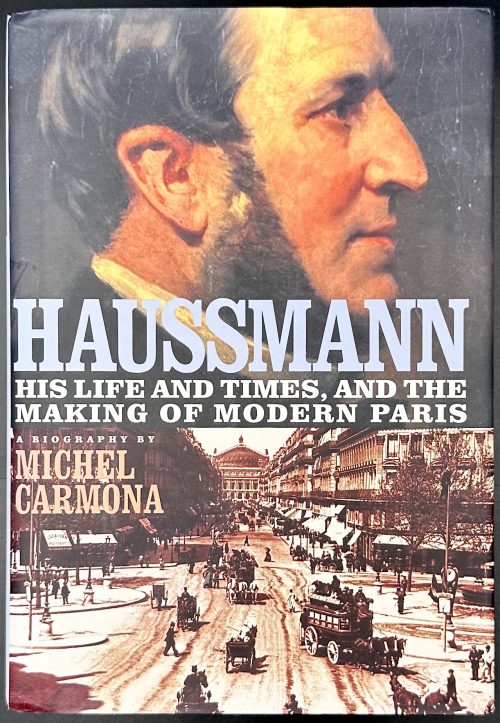 Hardcover, 242 x 168 mm, quarter burgundy cloth over blue paper boards, outer edge untrimmed; pp.: [6] [1-4] 5-516 [2 colophon/blank] [6 blanks]. First published in France in 2000 as “Haussmann” by Librairie Arthème Fayard. Title-page: HAUSSMANN | ~ | His Life and Times, | and the Making of Modern Paris | MICHEL CARMONA | TRANSLATED FROM THE FRENCH BY PATRICK CAMILER | {publisher’s device} | Ivan • R • Dee | Chicago 2002 || Michel Carmona (French, b. 1940) Georges-Eugène Haussmann [Baron Haussmann] (French, 1809 – 1891)
Hardcover, 242 x 168 mm, quarter burgundy cloth over blue paper boards, outer edge untrimmed; pp.: [6] [1-4] 5-516 [2 colophon/blank] [6 blanks]. First published in France in 2000 as “Haussmann” by Librairie Arthème Fayard. Title-page: HAUSSMANN | ~ | His Life and Times, | and the Making of Modern Paris | MICHEL CARMONA | TRANSLATED FROM THE FRENCH BY PATRICK CAMILER | {publisher’s device} | Ivan • R • Dee | Chicago 2002 || Michel Carmona (French, b. 1940) Georges-Eugène Haussmann [Baron Haussmann] (French, 1809 – 1891) -
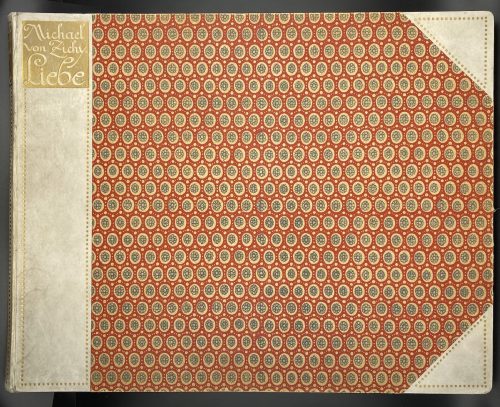 Oblong album of forty photogravures printed on wove paper in sanguine after drawings by Mihály Zichy; 31.5 x 40.5 cm gilt-decorated half-parchment over red boards with a gilt diaper design; embossed gilt label in the top left corner “Michael | von Zichy. | Liebe”. Anonymous edition. Bookplate to front pastedown: “P•U•H | EX | LIBRIS”. Photogravures made from the original watercolours and crayon drawings produced in 1874-1879; the original album consisted of 51 compositions was sold at Christie’s sale of Gérard Nordmann collection on December 14-15, 2006 in Paris. Some of these photogravures were reproduced photomechanically and printed in 1869 [LIB-2244.2019] and 1989 [LIB-2242.2019]. Limitation: 300 copies were privately printed in Leipzig in 1911 for subscribers only; photogravure copper plates were destroyed. This is copy № 285. Title-page (brown and black): MICHAEL VON ZICHY | LIEBE | VIERZIG ZEICHNUNGEN | PRIVATDRUCK LEIPZIG 1911 || Dimensions: album: 31.5 x 40.5 cm; sheets 31 x 40 cm, uncut. Catalogue raisonné: Bibliothèque érotique: Gérard Nordmann; Livres, manuscrits, dessins, photographies du XVIe au XXe siècle / Catalogues de ventes, seconde partie. — Paris: Christie’s, 2006; p. 280, № 564 (drawings); № 565 photogravures [LIB-2810.2021]. Contributors: Mihály Zichy [Michael von Zichy; Михаил Александрович Зичи] (Hungarian, 1827 – 1906).
Oblong album of forty photogravures printed on wove paper in sanguine after drawings by Mihály Zichy; 31.5 x 40.5 cm gilt-decorated half-parchment over red boards with a gilt diaper design; embossed gilt label in the top left corner “Michael | von Zichy. | Liebe”. Anonymous edition. Bookplate to front pastedown: “P•U•H | EX | LIBRIS”. Photogravures made from the original watercolours and crayon drawings produced in 1874-1879; the original album consisted of 51 compositions was sold at Christie’s sale of Gérard Nordmann collection on December 14-15, 2006 in Paris. Some of these photogravures were reproduced photomechanically and printed in 1869 [LIB-2244.2019] and 1989 [LIB-2242.2019]. Limitation: 300 copies were privately printed in Leipzig in 1911 for subscribers only; photogravure copper plates were destroyed. This is copy № 285. Title-page (brown and black): MICHAEL VON ZICHY | LIEBE | VIERZIG ZEICHNUNGEN | PRIVATDRUCK LEIPZIG 1911 || Dimensions: album: 31.5 x 40.5 cm; sheets 31 x 40 cm, uncut. Catalogue raisonné: Bibliothèque érotique: Gérard Nordmann; Livres, manuscrits, dessins, photographies du XVIe au XXe siècle / Catalogues de ventes, seconde partie. — Paris: Christie’s, 2006; p. 280, № 564 (drawings); № 565 photogravures [LIB-2810.2021]. Contributors: Mihály Zichy [Michael von Zichy; Михаил Александрович Зичи] (Hungarian, 1827 – 1906). -
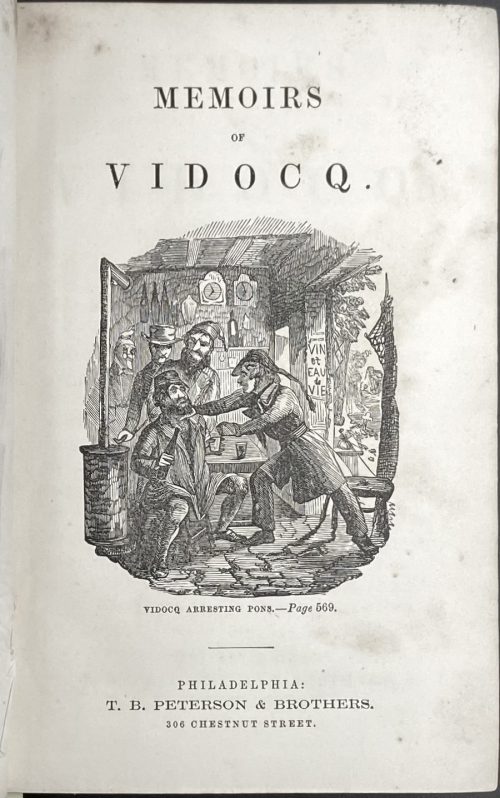 Title: MEMOIRS | OF | VIDOCQ. |THE | Principal Agent of the French Police. | WRITTEN BY HIMSELF, | AND TRANSLATED FROM THE | ORIGINAL FRENCH, EXPRESSLY FOR THIS EDITION. | WITH ILLUSTRATIVE ENGRAVINGS, | FROM | ORIGINAL DESIGNS BY CRUIKSHANK. | PHILADELPHIA: | T. B. PETERSON AND BROTHERS, | 306 CHESTNUT STREET. || Pagination: ffl, engraved frontispiece w/guard, engraved t.p., [2] t.p. / copyright, 19-580, [12], [2] 3-17 [18-30], bfl + 4 plates. Collation: 8vo; [1]8 2-358 362 + 22 leaves of advert., + frontis., t.p., 4 plates. Correct collation despite pagination starts at p. 19. Binding: Publisher's brown pebbled cloth, front stamped in blind, gilt spine lettering, yellow endpapers. Owner's ink inscription to ffl, dated 1936. Ref.: HathiTrust and OCLC identify the plates as 'by George Cruikshank' though none is signed. Authorship of Eugène-François Vidocq (French, 1775 – 1857) is doubtful too. The translator is not stated.
Title: MEMOIRS | OF | VIDOCQ. |THE | Principal Agent of the French Police. | WRITTEN BY HIMSELF, | AND TRANSLATED FROM THE | ORIGINAL FRENCH, EXPRESSLY FOR THIS EDITION. | WITH ILLUSTRATIVE ENGRAVINGS, | FROM | ORIGINAL DESIGNS BY CRUIKSHANK. | PHILADELPHIA: | T. B. PETERSON AND BROTHERS, | 306 CHESTNUT STREET. || Pagination: ffl, engraved frontispiece w/guard, engraved t.p., [2] t.p. / copyright, 19-580, [12], [2] 3-17 [18-30], bfl + 4 plates. Collation: 8vo; [1]8 2-358 362 + 22 leaves of advert., + frontis., t.p., 4 plates. Correct collation despite pagination starts at p. 19. Binding: Publisher's brown pebbled cloth, front stamped in blind, gilt spine lettering, yellow endpapers. Owner's ink inscription to ffl, dated 1936. Ref.: HathiTrust and OCLC identify the plates as 'by George Cruikshank' though none is signed. Authorship of Eugène-François Vidocq (French, 1775 – 1857) is doubtful too. The translator is not stated. -
 Title: MEMOIRS OF M. THIERS | 1870—1873 | Translated by | F. M. ATKINSON | {publisher’s device} | LONDON: GEORGE ALLEN & UNWIN LTD. | RUSKIN HOUSE 40 MUSEUM STREET, W.C. Pagination: [6] 7-384. Collation: 8vo; [1]-248. Size: 23 x 15 cm Binding: Blue cloth, top and bottom ruled in blind, gilt lettering to front cover and spine. Original: Adolphe Thiers. Notes et souvenirs de M. Thiers, 1870-1873: voyage diplomatique, proposition d'un armistice, préliminaires de la paix, présidence de la République. — Paris : [s.n.], 1901. — 465 p. The preface and editing signed "F. D." [Félicie Dosne]. Félicie Dosne (French, 1823 – 1906) was Thiers's sister-in-law.
Title: MEMOIRS OF M. THIERS | 1870—1873 | Translated by | F. M. ATKINSON | {publisher’s device} | LONDON: GEORGE ALLEN & UNWIN LTD. | RUSKIN HOUSE 40 MUSEUM STREET, W.C. Pagination: [6] 7-384. Collation: 8vo; [1]-248. Size: 23 x 15 cm Binding: Blue cloth, top and bottom ruled in blind, gilt lettering to front cover and spine. Original: Adolphe Thiers. Notes et souvenirs de M. Thiers, 1870-1873: voyage diplomatique, proposition d'un armistice, préliminaires de la paix, présidence de la République. — Paris : [s.n.], 1901. — 465 p. The preface and editing signed "F. D." [Félicie Dosne]. Félicie Dosne (French, 1823 – 1906) was Thiers's sister-in-law.


